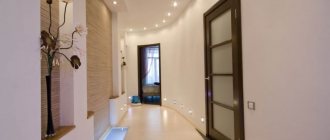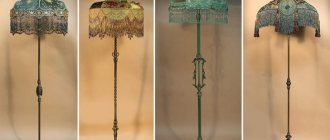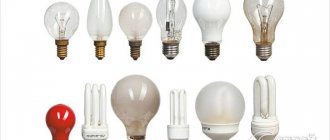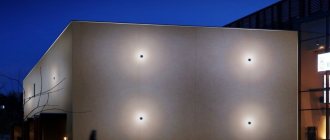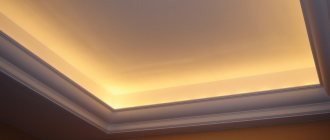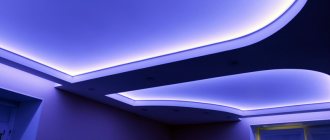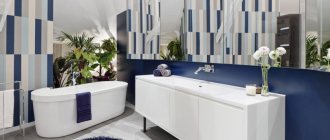The role of light in the formation of space is difficult to overestimate. Properly constructed lighting can visually transform the volume of space without affecting the structure and architecture. Incorrect lighting can completely destroy the designer’s entire idea. Lighting design - the art of controlling light. The task of a lighting designer is to create an attractive and comfortable space, take into account the interaction with the environment, and consider the impact on a person’s emotions and mood. This art is based on a scientific understanding of the physical aspects of light, the principles of design and operation of light sources.
In his work, the lighting designer relies on 3 bases: aesthetic perception, ergonomic aspect and energy efficiency.
Today lighting design is a popular trend. Until the 18th century, people had only solar, lunar and fire light at their disposal. And this did not stop him from creating stunning works of architecture and interior design. Currently, lighting designers have a huge selection of lighting devices and light sources to solve almost any problem.
Modern lighting designers are able to create amazing illusions, change the perception of space, enhance and emphasize details. They care about the beauty and style of interiors and exteriors, and take into account the safety and energy efficiency of projects.
Lighting design is a complex and multifaceted science that is always connected with creativity and art. Let's try to understand the basics of this direction and the features of proper planning of light in the interior.
Types of lighting
Type 1: basic (general) lighting. The goal is to provide a sufficient amount of light in the room and display the overall design concept of the room. Basic lighting can be achieved using chandeliers, pendant, overhead and built-in lighting fixtures.
Type 2: accent lighting. It creates an atmosphere and a finished look in the room. Accent light is used when necessary to show the viewer the “content” of the interior, to form an idea of the spatial arrangement of objects. With its help, objects are emphasized: vases, figurines and other objects that deserve emphasis.
Type 3: local lighting. This light is used to solve functional problems: creating comfortable conditions for reading, working or cooking.
For this purpose, built-in lamps, table lamps, sconces or floor lamps above the work area.
Ambient lighting
It occurs with the help of shadow transitions, it is perceived favorably and does not irritate the eyes. Such lighting can be obtained by using lamps in the shape of a ball or hemisphere; the glass should be frosted. Another way to achieve diffuse lighting is to use halogen lamps in the ceiling area.
“Halogen” lights are mounted on brackets that are installed in the ceiling or wall. You can make a design in such a way that it will change the angle of lighting.
Types of luminous flux distribution
Direct light. The luminous flux comes from the emitter and is directed to the place that should be illuminated. Examples of direct light lamps include spotlights, spots, downlights, pendant lamps, the luminous flux of which is directed in a certain direction (for example, in loft and minimalist interiors) or ceiling lamps. They provide the necessary level of illumination on the surface without illuminating the rest of the space.
Scattered light. Soft and smooth, it reduces contrast levels and minimizes shadows. Light that has no direction or source fits the definition of diffuse light, but such light cannot exist in the real world. Therefore, dim, unsharp lighting is called diffused. Some types of chandeliers, ceiling and wall lamps will help to create such light in a room.
Reflected light. Reflected light is produced by the refraction of a beam that is directed toward walls, floors, or ceilings.
This type of light is the most natural and soft. Manufacturers create lamps that shine only with reflected light, but there are models that combine direct and reflected light. Depending on the task, you can choose the most suitable option for yourself.
Lamp categories
Lamps in the interior are selected according to several criteria to ensure the required effect and conditions.
1. Color rendition:
- daylight . Daylight is possible in the kitchen, above the workplace, above the sewing machine - it makes your eyes less tired. And also in the hallway, which usually has no windows.
- warm light . With a slightly yellowish tint, the warm light is very cozy, slightly relaxing, and therefore most preferred by the user.
- cold light . The coolest light is suitable for festive and public interiors, such as bars and clubs.
For residential premises, it is worth taking lamps that indicate a color rendering characteristic of 90-100 Ra. This is the most comfortable value for the human eye. If the light bulb you bought is of the usual power, but hurts your eyes, then the manufacturer ignored the color rendition. It’s better not to use it, buy another one, carefully looking to see if these 90-100 Ra are there.
2. Light bulb power:
If we talk about the power of a light bulb, then we need to assume that for one square meter you need from 15 to 20 watts. This means that for standard city apartments it is absolutely enough:
- 100 W light bulbs in the bathroom; — in the toilet — 80W; — in corridor 2, 200 W; - in the kitchen and living rooms - 100-150W.
Having sorted out the shades, it is worth paying attention to the types of lamps, as well as determining where they fit.
Types of lighting
Natural light. Its sources are the sun's rays and the diffused light of the sky. The spectral composition of the sun's rays has a beneficial effect on a person's emotional state. Using this type of lighting when working on a room project is one of the tasks of a lighting designer.
Artificial light. The main task of artificial light sources in room design is to create a comfortable level of lighting when there is a shortage of sunlight. Modern sources of artificial light are most often lamps. Lamps direct the light. Using certain light sources can create a semblance of natural light.
Combined light. An option when natural lighting is supplemented with artificial light sources. This will increase illumination in the right areas of the room and create a comfortable environment.
Use natural light where possible. Combine lighting to achieve beauty and comfort.
LED illumination of photo frames and paintings
Purchasing illuminated photo frames from a store can sometimes be expensive. Or you can’t get a frame of the right size. Then you can design frames for paintings or photographs yourself. The ease of installation of the LED strip will help you get the desired result, an original piece of furniture and an additional light source.
Decorative lighting can be built into a picture or cabinet
The lighting of the room in the corners will look especially beautiful.
At night, the kitchen will look even better if you add lighting like this
See alsoChandeliers in the interior
Key rules of interior lighting design
So, we have figured out the basic concepts of lighting design in an apartment and types of lighting. But how can they be properly organized and applied in practice?
Professional interior lighting designers have developed a general concept where the fundamental concept is light and its significance in human life.
Light to live. Light is vital for everyone. It supports the body's abilities and the flow of physiological processes. This role is played by natural lighting, which is why it stands at the top of the light pyramid.
Light to see. We need light to navigate space in the dark - not to bump into each other in the corridor, not to step on the dog’s paw and to move safely around the house. This is where artificial light comes into play.
Light to work with. We are talking about the light that is necessary for reading, writing, cooking and other daily activities without which a person cannot imagine his life.
Light to feel. Lighting acts as a decorative element of the interior. With the help of light in the interior, it becomes possible to focus attention on details, change the space and implement bold design solutions. The pleasant atmosphere of the room and a favorable emotional state are the merit of well-designed lighting.
Recently, it has become fashionable and convenient to create lighting scenarios. This became possible thanks to modern technologies that allow you to control lighting, set up various scenarios for certain tasks or required conditions (watching TV, reading books, receiving guests, partying, etc.). This is a separate and interesting topic.
The article outlines general concepts related to the issue of lighting design. Subscribe to our blog to stay up to date with lighting planning features.
Features of lighting design in the hallway
The hallway, as a rule, is characterized by small size and insufficient or complete absence of natural light. It is desirable that wall and ceiling lamps have a closed shape, so that the light bulb remains invisible from anywhere in the room or has a matte coating.
Lighting in the hallway and corridor
It is better to choose opaque lampshades for sconces, since the lamps can dazzle at close range. These rules apply to any small premises.
Separately in the hallway it is worth highlighting the hanger and the area near the mirror. If the room is square or close to square, then a central ceiling lamp with several shades will be sufficient; the ability to direct the shade in the desired direction will allow you to illuminate the desired area of the hallway.
Lighting in the hallway and corridor
To illuminate an elongated room, it is better to use several sconces located at different ends or several lamps evenly distributed along the ceiling. For corridors and hallways, 50-100 lux is usually sufficient.
The living room is a room that performs several functions: it welcomes guests, watches TV, communicates, and reads. The main secret of good lighting is its own lamp for each function. This means that in the living room you need to create several islands of light at different levels, it’s good if their brightness can be adjusted, the main thing is that the lamps are made in the same style and correspond to the general idea of interior decoration.
Multi-level lighting in the living room
Near sofas and armchairs, it makes sense to place floor lamps or sconces that create diffused light. Architectural and decorative elements of the interior - columns, arches, exposed brickwork - will look impressive if they are illuminated with spot floor or ceiling lamps.
Decorative lighting in the living room
Multi-level ceilings with lighting will allow you to highlight individual zones and create light accents. It is in the living room that original lighting options that highlight the overall style of the interior will be very appropriate. Read more about lighting and the location of sockets in the living room in this article.
Light scenario for the living room
LED lighting for cornices and curtains
Using LED strips you can beautifully decorate curtains. Based on your taste or listening to the advice of experts, you can add curtains made of light fabric or heavy noble material. The tape is attached to the fabric both at the top and at the bottom of the curtain. A ribbon selected taking into account color and style solutions will look especially stylish. The color can be matched to any material.
Typically, decorative lighting is installed together with a suspended ceiling
You can install illuminated photo wallpaper in the kitchen
See also 3D panels in the interior, photo.



